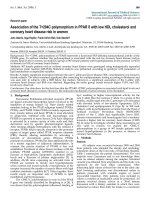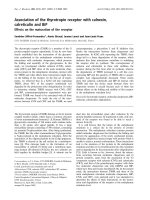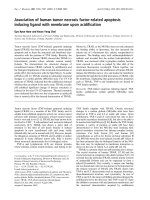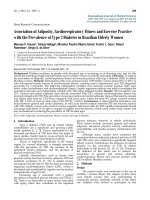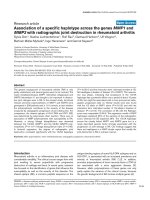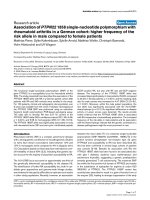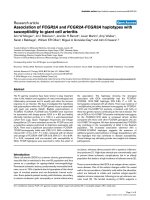Báo cáo y học: "Association of nail biting and psychiatric disorders in children and their parents in a psychiatrically referred sample of children" ppsx
Bạn đang xem bản rút gọn của tài liệu. Xem và tải ngay bản đầy đủ của tài liệu tại đây (233.63 KB, 7 trang )
BioMed Central
Page 1 of 7
(page number not for citation purposes)
Child and Adolescent Psychiatry and
Mental Health
Open Access
Research
Association of nail biting and psychiatric disorders in children and
their parents in a psychiatrically referred sample of children
Ahmad Ghanizadeh
1,2
Address:
1
Assistant Professor of Child and Adolescent Psychiatry, Shiraz University of Medical Sciences, Hafez Hospital, Shiraz, Iran and
2
Director
of Research Center for Psychiatry and Behavioral Sciences, Shiraz University of Medical Sciences, Hafez Hospital, Shiraz, Iran
Email: Ahmad Ghanizadeh -
Abstract
Background: Nail biting (NB) is a very common unwanted behavior. The majority of children are
motivated to stop NB and have already tried to stop it, but are generally unsuccessful in doing so.
It is a difficult behavior to modify or treat. The objective of this study was to investigate the
prevalence of co-morbid psychiatric disorders in a clinical sample of children with NB who present
at a child and adolescent mental healthcare outpatient clinic and the prevalence of psychiatric
disorders in their parents.
Method: A consecutive sample of 450 referred children was examined for NB and 63 (14%) were
found to have NB. The children and adolescents with nail biting and their parents were interviewed
according to DSM-IV diagnostic criteria. They were also asked about lip biting, head banging, skin
biting, and hair pulling behaviors.
Results: Nail biting is common amongst children and adolescents referred to a child and
adolescent mental health clinic. The most common co-morbid psychiatric disorders in these
children were attention deficit hyperactivity disorder (74.6%), oppositional defiant disorder (36%),
separation anxiety disorder (20.6%), enuresis (15.6%), tic disorder (12.7%) and obsessive
compulsive disorder (11.1%). The rates of major depressive disorder, mental retardation, and
pervasive developmental disorder were 6.7%, 9.5%, 3.2%, respectively. There was no association
between the age of onset of nail biting and the co-morbid psychiatric disorder. Severity and
frequency of NB were not associated with any co-morbid psychiatric disorder. About 56.8% of the
mothers and 45.9% of the fathers were suffering from at least one psychiatric disorder. The most
common psychiatric disorder found in these parents was major depression.
Conclusion: Nail biting presents in a significant proportion of referrals to a mental healthcare
clinic setting. Nail biting should be routinely looked for and asked for in the child and adolescent
mental healthcare setting because it is common in a clinical population, easily visible in consultation
and relatively unintrusive to ask about. If present, its detection can then be followed by looking for
other more subtle stereotypic or self-mutilating behaviors.
Published: 2 June 2008
Child and Adolescent Psychiatry and Mental Health 2008, 2:13 doi:10.1186/1753-2000-2-
13
Received: 16 August 2007
Accepted: 2 June 2008
This article is available from: />© 2008 Ghanizadeh; licensee BioMed Central Ltd.
This is an Open Access article distributed under the terms of the Creative Commons Attribution License ( />),
which permits unrestricted use, distribution, and reproduction in any medium, provided the original work is properly cited.
Child and Adolescent Psychiatry and Mental Health 2008, 2:13 />Page 2 of 7
(page number not for citation purposes)
Co-morbidity of psychiatric disorders in children
with nail biting and psychiatric characteristic of
their parents in a clinical sample
Onychophagia or nail biting (NB) is a behavior with a
wide spectrum. It is characterized by putting the nail into
the mouth in such a manner that contact occurs between
a fingernail and one or more teeth. This could also lead to
a damaged or bleeding nails. Sometimes it results in phys-
ical damage and is considered as a self-mutilative behav-
ior [2,3]. The gums may even be damaged [4]. Sometimes
the nail is bitten until it is lost, the fingers are bitten and
the cuticle and the nail-bed skin is chewed [5].
Mild forms of onychophagia had been compared to nerv-
ous habits such as fidgeting [6]. Therefore, some studies
make a distinction between mild forms and severe forms
of nail biting [7]. There is no specific diagnostic category
for a number of prevalent habit disorders such as nail-bit-
ing in the Diagnostic and Statistical Manual of Mental
Disorders, Fourth Edition-Text Revision. Nail biting could
be categorized as an 'impulse control disorders not other-
wise specified'.
Onychophagia is an unwanted behavior which can make
a person nervous in social situations [5]. It is interesting
that the majority of children with NB are motivated to
stop NB and have already tried to stop it, but have been
generally unsuccessful in doing so. The prevalence of nail
biting is probably underestimated because of its secrecy
and this may lead to under-recognition by medical profes-
sionals. The rate of nail-biting in USA preschool children,
aged 3 to 6 years, has been as 23% [8]. In an epidemiolog-
ical study on 4590 school children in India, the rate of NB
was reported as 12.7% [9]. A review article reported that
up to 33% of children aged 7 to 10 years and 45% of ado-
lescents are nail biters [10]. Another epidemiological
study on 5554 children aged 5–13 year old in India
showed that girls were more frequently thumb sucking
than boys [11]. The rate of NB decreases with the increase
in age [8]. In these previous studies, the severity of nail bit-
ing was not considered.
A genetic basis for onychophagia has been reported [12].
Onychophagia might be a sign of anxiety and might serve
as an anxiety-reducing function [7,13]. Other studies have
reported anxiety and nervousness as the etiology of ony-
chophagia [14]. On the one hand one study has reported
that it is more than a "nervous habit" and anxious patients
more likely perceive their nail biting as a problem [15].
On the other hand, lack of higher anxiety in children with
nail biting shows that anxiety is a state rather than a trait
[16]. Other researchers have reported that onychophagia
is an acquired habit which does not reflect an underlying
emotional disturbance [17]. Onychophagia in pediatric
dermatology practice may involve an underlying obses-
sive-compulsive disorder [18]. An older study has
reported that there is a higher rate of nail biting in socio-
paths as compared to the control population [19]. How-
ever, nail biting, especially benign forms of nail biting,
can also present without any accompanying psychiatric
disorder.
Onychophagia is reported to be a difficult behavior to
modify. Long term effects of habit reversal which include
awareness training, the practice of an incompatible behav-
ior and relaxation have not yielded impressive results
[20]. Furthermore, research has shown that drugs are not
effective for treatment of nail biting and habit reversal
techniques were not effective in long term [7]. These diffi-
culties may have arisen from insufficient knowledge
about NB. Therefore, there is a need to know more about
NB in order to reduce or eliminate it. Increasing awareness
of co-morbidities that may be associated with NB may
ultimately lead to new approaches.
To the best of the author's knowledge, no study has been
conducted to investigate psychiatric co-morbidity in chil-
dren and adolescents with nail biting. This study surveys
prevalence of psychiatric disorders and the stereotypic
behaviors in a clinical sample of children and adolescents
with NB. In addition, it aimed to survey prevalence of the
psychiatric disorders in parents of children and adoles-
cents with NB.
Method
Sample description
This study was undertaken on a consecutive sample of
children and adolescents with nail biting and their par-
ents at the Child and Adolescent Psychiatry Clinic of
Shiraz University of Medical Sciences, Fars, Iran. The
patients in this consecutive sample were referred to the
clinic for different reasons, not just for nail biting. Our
average annual patient referral is about 1500. 66 children
and adolescents with NB were identified out of a total of
about 450 patients referred over 4 months. This repre-
sented about one third of the total referrals to the service
in this period, a significant proportion of the total refer-
rals. These 66 children were typical referrals in general,
with more than two third of them were suffering from dis-
ruptive behavior disorders, which matches the proportion
of disruptive behavior disorders in our general referrals.
Only 3 patients refused to take part in the study because it
was very time consuming, leaving a total of 63 children
and adolescents who participated in this study together
with their parents.
Measurements
Children
Since there are no objective measures to assess nail biting
quantitatively, the numbers of days per week whereby the
Child and Adolescent Psychiatry and Mental Health 2008, 2:13 />Page 3 of 7
(page number not for citation purposes)
patients would bite their nails was considered as an indi-
cator of severity. Furthermore, duration of NB behavior
was elicited with the question, "How many months has
he/she bitten his/her nail(s)?" This was assessed based on
retrospective self-report of the patient and the estimation
of parents. In a pilot study, there was generally good reli-
ability using these methods, and parent and child
accounts generally coincided. In the event of a discrep-
ancy between parent and child reports, the parents' report
was given priority. In addition, gross physical damage of
NB was examined and assessed by the physician.
Psychiatric disorders in children and adolescents were
diagnosed by face-to-face interview with them and their
parents using Kiddie Schedule for Affective Disorders and
Schizophrenia-Present and Lifetime Version (K-SADS-PL)
[Farsi version] [21]. K-SADS-PL is a semi-structured diag-
nostic interview for children and adolescents, based on
DSM-IV diagnostic criteria. The K-SADS-PL Farsi version
has sufficient validity and reliability for the assessment of
child and adolescent psychiatric disorders. It has already
been used in many different studies in Iran [22,23]. The
stereotypic behaviors including lib biting, bruxism, head
banging, skin biting and hair pulling were also surveyed.
Parents
The parents were also invited to be interviewed for screen-
ing of their own co-morbid current psychiatric disorders
using a structural clinical interview by the Schedule for
Affective Disorders and Schizophrenia (SADS) and DSM-
IV diagnostic criteria [24,25]. The reliability and validity
of SADS in Iranian subjects has been previously reported
[26,27]. In addition, the parents were asked about lip bit-
ing, head banging, skin biting, and hair pulling behaviors.
The diagnoses were made by the child and adolescent psy-
chiatrist.
The children and adolescents and their parents were
informed about the study objectives and they gave con-
sent to participate in the study. Adequate explanation was
given to them: the information collected would be confi-
dential. They would only be used for writing an article,
which should improve the life of children with NB and
their families through increasing the knowledge about
NB. The study was conducted according to the Good Clin-
ical Practice Guidelines, in accordance with the Declara-
tion of Helsinki, 1975, as revised in 2000.
Analysis
The data were statistically analyzed with SPSS. Chi-
squared analysis was used for categorical data and contin-
uous data was analyzed using non-parametric tests. Statis-
tical significance was defined as 5% level.
Results
63 children and adolescents aged 5 to 18 years old partic-
ipated in this study. The mean age of the children was 9.4
(SD = 3.3) years. Boys comprised 65.1% of the sample.
About 58% of them were the first child in the family and
about 31% of them were the only child. The mean dura-
tion of NB in the sample was 3.5 (SD = 2.7) years. The
duration range was 6 months to 15 years. However,
nobody was excluded because of their NB duration.
Co-morbid psychiatric disorders and the stereotypic
behaviors in children and adolescents with NB
Table 1 shows the distribution of co-morbid psychiatric
disorders by gender. More boys were suffering from at
least one of the psychiatric disorders than girls (X
2
= 7.9,
df = 1, P < 0.01). The most common co-morbid psychiat-
ric disorders in the children were attention deficit hyper-
activity disorder (ADHD) 74.6%, oppositional defiant
disorder (ODD) 36%, separation anxiety disorder (SAD)
20.6%, enuresis 15.6%, tic disorder 12.7%, and obsessive
compulsive disorder (OCD) 11.1%. The rate of major
Table 1: Association of frequency of the psychiatric disorders by gender in children with nail biting.
Disorder Boys (n = 41) Girls (n = 22)
n%n%
Attention deficit hyperactivity disorder (n = 47) 32 78.0 15 68.2
Oppositional defiant disorder (n = 23) 16 39.0 7 31.8
Conduct disorder (n= 4) 4 9.8 0 0.0
Tic disorder(n- = 8) 7 17.1 1 4.5
Major depressive disorder (n = 4) 2 4.9 2 9.1
Separation anxiety disorder (n = 13) 8 19.5 5 22.7
Mental retardation (n = 6) 5 12.2 1 4.5
Obsessive compulsive disorder (n = 7) 6 14.6 1 4.5
Enuresis(n = 10) 10 24.4 0 0.0
Pervasive developmental disorder (n = 2) 24.900.0
At least one of the above psychiatric disorders (n = 59) 41 100 18 81.8
Child and Adolescent Psychiatry and Mental Health 2008, 2:13 />Page 4 of 7
(page number not for citation purposes)
depressive disorder (MDD), mental retardation (MR),
and pervasive developmental disorder (PDD) were 6.7%,
9.5%, 3.2%, respectively. There was no case of schizophre-
nia.
There was no statistical relationship between the age of
the onset of nail biting and the co-morbid psychiatric dis-
order (Table 2). Also, there was no association between
frequencies of nail biting per week with the co-morbid
psychiatric disorder. Gross physical damage due to nail
biting was not related to the co-morbid psychiatric disor-
der (Table 3).
More than half of the children with nail biting (65.1%)
had at least one stereotypic behavior. The most common
co-morbid stereotypic behavior was lip biting (Table 4).
Thirty-seven fathers and 58 mothers were also inter-
viewed. The response rates of the fathers and mothers
were 58.7% and 92%, respectively.
Co-morbid psychiatric disorders in parents of children and
adolescents with NB
Table 5 shows the frequency of co-morbid psychiatric dis-
orders among the parents of children and adolescents
with nail biting. Among the parents who were inter-
viewed, about 56.8% of the mothers and 45.9% of the
fathers were suffering from at least one psychiatric disor-
der. The most common psychiatric disorder concerning
the parents was MDD. About 35.1% of the interviewed
fathers and 46.6% of the interviewed mothers were suffer-
ing from MDD. The rate of anxiety disorders was much
lower than the MDD rate. The rate of nail biting was
higher than the rate of anxiety disorder regarding the
mothers, although it was not statistically significant (X
2
=
0.04, df = 1, P = 0.8).
Discussion
This study of children and adolescents presenting at a
mental healthcare clinic showed that 65% of children
with nail biting had at least one of the other stereotypic
behaviors. More than two-thirds of children who have NB
who are referred to a mental health clinic are also suffer-
ing from at least one major co-morbid psychiatric disor-
der. Two-thirds of the interviewed parents were also
suffering from at least one major psychiatric disorder,
especially MDD. Unfortunately, no study about the co-
morbidity of psychiatric disorders in children with NB,
co-morbidity of NB in children with psychiatric disorders,
or any study about the prevalence of psychiatric disorders
concerning parents of children with NB were found to
compare with the current results.
The results of this study do not appear to support previous
studies which report that onychophagia is a sign of anxi-
ety or that anxiety and nervousness are etiological factors
for onychophagia [7,13,14]. Also, these results are not
consistent with the study that concluded that ony-
chophagia does not reflect any underlying emotional dis-
Table 2: Association of onset age of nail biting by the psychiatric disorders
Disorder Mean age of onset Significance*
With ADHD (n = 46) 6.2 U = 267.5, N1 = 46, N2 = 16, p = 0.1
Without ADHD(n = 16) 5.3
With ODD(n = 23) 5.2 U = 383.5, N1 = 39, N2 = 23, p = 0.3
Without ODD(n = 39) 6.4
With CD(n = 4) 4.7 U = 96.0, N1 = 58, N2 = 4, p = 0.5
Without CD(n = 58) 6
With Tic(n = 8) 6.4 U = 188.5, N1 = 8, N2 = 54, p = 0.5
Without Tic(n = 45) 5.9
With MDD(n = 4) 11.4 U = 188.5, N1 = 4, N2 = 54, p = 0.5
Without MDD(n = 58) 5.6
With SAD(n = 12) 5.5 U = 53.5, N1 = 12, N2 = 50, p = 0.07
Without SAD(n = 50) 6.0
With Enuresis(n = 10) 4.9 U = 222.0, N1 = 10, N2 = 52, p = 0.4
Without Enuresis(n = 52) 6.1
With OCD(n = 7) 6.7 U = 158.0, N1 = 7, N2 = 55, p = 0.4
Without OCD(n = 55) 5.8
With PDD(n = 2) 7.0 U = 44.0, N1 = 2, N2 = 60, p = 0.5
Without PDD(n = 60) 5.9
With MR(n = 6) 5.5 U = 124.0, N1 = 6, N2 = 56, p = 0.3
Without MR(n = 56) 6.0
ADHD = Attention deficit hyperactivity disorder, ODD = Oppositional defiant disorder, CD = Conduct disorder, MDD = Major depressive
disorder, SAD = Separation anxiety disorder, MR = Mental retardation, OCD = Obsessive compulsive disorder, PDD = Pervasive developmental
disorder
* Mann-Whitney U test.
Child and Adolescent Psychiatry and Mental Health 2008, 2:13 />Page 5 of 7
(page number not for citation purposes)
turbance [17]. A possible explanation of this lack of
consistency is that children and adolescents with psychi-
atric disorders who also have NB may not be typical of
children and adolescents in the community who have NB.
Nail biting is considered by some to be a variant of nor-
mal tactile and environmental exploration. However, it
should be noted that this behavior causes physical dam-
age and distress as well as a motivation to change, and
therefore cannot be considered benign in children. NB is
usually associated with psychiatric disorders in this clini-
cal sample. One explanation is that although NB might be
associated with anxiety and functions as a tension reduc-
tion behavior, this tension and anxiety may be secondary
to another psychiatric disorder such as ADHD and its con-
sequences. Affected patients are aware of their habit and
admit their continual nail biting, but they seem unable to
control it. It is not possible to determine whether the pres-
ence of co-morbid psychiatric disorders is a cause or a
consequence of NB.
Onychophagia is reported to be a difficult behavior to
modify and the treatment results are not as impressive as
initially reported [20]. Furthermore, research has shown
that drugs are not effective for treatment of nail biting and
habit reversal techniques are not effective in the long term
[7]. It is possible that low rates of success in treatment
might be related to lack of sufficient knowledge about the
co-morbidity of psychiatric disorders in children with NB
or psychiatric disorders in their parents, and therefore the
lack of sufficient resources directed to dealing with under-
lying causes or maintaining factors. One suggestion
would be that future interventional studies on NB should
be conducted with special attention to identifying and
addressing any psychiatric disorders in these children or
adolescents and their parents. This way, it can be deter-
mined if treating co-morbid psychiatric disorders in these
cases can increase effectiveness of dealing with the NB.
The results of this study suggest that psychiatrists should
look for nail biting amongst their patients who present
with mental healthcare problems. NB seen in this setting
may indicate anxiety. Nail biting, which causes distress to
Table 3: Association of gross physical damage of nail by the psychiatric disorder
Disorder Gross physical damage (%) Significance
Attention deficit hyperactivity disorder With (n = 43) 37.2 χ
2
= 0.1, df = 1, p = 0.4
Without (n = 14) 42.9
Oppositional defiant disorder With(n = 21) 47.6 χ
2
= 1.1, df = 1, p = 0.2
Without (n = 36) 33.3
Conduct disorder With(n = 3) 66.7 -
Without (n = 54) 37.0
Tic disorder With(n = 8) 62.5 χ
2
= 0.2, df = 1, p = 0.1
Without (n = 49) 34.7
Major depressive disorder With(n = 3) 0.0 -
Without (n = 54) 40.7
Separation anxiety disorder With(n = 10) 30 χ
2
= 0.7, df = 1, p = 0.4
Without (n = 47) 40.4
Mental retardation With(n = 5) 40 -
Without (n = 52) 38.5
Obsessive compulsive disorder With(n = 7) 57.1 χ
2
= 0.4, df = 1, p = 0.2
Without (n = 50) 36.0
Enuresis With(n = 8) 50 χ
2
= 0.6, df = 1, p = 0.3
Without (n = 49) 36.7
*Fisher's exact test
Table 4: Co-morbidity of the other stereotypic behavior in the children with nail biting
Disorder Total (%) Boy (%) Girl (%)
Lip biting (n = 21) 33.3 26.8 45.5
Bruxism (n = 17) 27 22 36.4
Head banging (n = 11) 17.5 22 9.1
Skin biting (n = 8) 12.7 14.6 9.1
Hair pulling (n = 7) 11.1 7.3 18.2
one or more co-morbid stereotypic behaviors 65.1 58.5 77.3
Child and Adolescent Psychiatry and Mental Health 2008, 2:13 />Page 6 of 7
(page number not for citation purposes)
the child and adolescent, may also be an issue that can be
used as a way to discuss motivation for change in general.
Care should be taken about generalization of the results
because the sample size was relatively low and the partic-
ipants were exclusively children and adolescents who
were referred to the psychiatric clinic for different reasons,
not solely for NB. Furthermore, NB duration range was at
least 6 months to 15 years. It might show that children
with milder forms of NB are less likely to suffer from co-
morbid psychiatric disorders and are therefore not as
likely to be referred to this clinic; and that this clinical
sample consisted of children and adolescents with moder-
ate or severe forms of both nail biting and psychiatric dis-
orders. These might have been key reasons, rather than
nail biting per se, for the high co-morbidity rates found in
the participants and their parents. Further studies in the
general population are recommended.
Competing interests
The author declares that they have no competing interests.
Acknowledgements
The author thanks Dr. Shokrpour and Dr Hanjani for their invaluable help
in English editing of the manuscript. The author thanks Professor Jacinta
Tan for her helpful comments.
References
1. Salmon-Ehr V, Mohn C, Bernard P: Longitudinal melanonychia
consecutive to nail biting. Annales De Dermatologie Et De Venere-
ologie 1999, 126:44-45.
2. Hatjigiorgis CG, Martin JW: An interim prosthesis to prevent lip
and cheek biting. J Prosthet Dent 1988, 59:250-252.
3. Lyon LS: A behavioural treatment of compulsive lip biting. J
Behav Ther Exp Psychiatry 1983, 14:275-276.
4. Krejci CB: Self-inflicted gingival injury due to habitual finger-
nail biting. J Periodontol 2000, 71:1029-1031.
5. Money J, Wolff G, Annecilo C: Pain agnosia and self-injury in the
syndrome of reversible somatropin deficiency (psychosocial
dwarfism). J Autism Child Schizophr 1972, 2:127-139.
6. Joubert CE: Incidence of some oral-based habits among col-
lege students and their correlations with use of oral stimu-
lants. Psychol Rep 1993, 72:735-738.
7. Wells JH, Haines J, Williams CL: Severe morbid onychophagia:
the classification as self-mutilation and a proposed model of
maintenance. Aust N Z J Psychiatry 1998, 32:534-545.
8. Foster LG: Nervous habits and stereotyped behaviors in pre-
school children. J Am Acad Child Adolesc Psychiatry 1998,
37:711-717.
9. Shetty SR, Munshi AK: Oral habits in Children – a prevalence
study. J Ind Soc of Pedo Prev Dent 1998, 16:61-66.
10. Leung AK, Robson WL: Nailbiting. Clin Pediatr (Phila) 1990,
29:690-692.
11. Kharbanda OP, Sidhu SS, Sundaram K, Shukla DK: Oral habits in
school going children of Delhi: A prevalence study. J Indian Soc
Pedod Prev Dent 2003, 21(3):120-124.
12. Bakwin H: Nail-biting in twins.
Dev Med Child Neurol 1971,
13:304-307.
13. Leonard HL, Lenane MC, Swedo SE, Rett DC, Rapoport JL: A double
blind comparison of clomipramine and desipramine treat-
ment of severe onychophagia (nail biting). Arch Gen Psychiatry
1991, 48:821-827.
14. McClanahan TM: Operant learning (R-S) principles applied to
nail biting. Psychol Rep 1995, 77:507-514.
15. Joubert CE: Incidence of some oral-based habits among col-
lege students and their correlations with use of oral stimu-
lants. Psychol Rep 1993, 72:735-738.
16. Gilleard E, Eskin M, Savasir B: Nail biting and oral aggression in
a Turkish students population. Br J Med Psychol 1998,
61:197-201.
17. Silber KP, Haynes CE: Treating nailbiting: a comparative analy-
sis of mild aversion and competing response therapies. Behav
Res Ther 1992, 30:15-22.
18. Koo JY, Smith LL: Obsessive-compulsive disorders in the pedi-
atric dermatology practice. Pediatr Dermatol 1991, 8:107-113.
19. Walker BA, Ziskind E: Relationship of nailbiting to sociopathy.
J Nerv Ment Dis 1977, 164(1):64-65.
20. Adesso VJ, Norberg MM: Behavioral interventions for oral-dig-
ital habits. In Tic disorders, trichotillomania, and other repetitive behavior
disorders: Behavioral approaches to analysis and treatment Edited by:
Woods DW, Miltenberger RG. Boston: Kluwer Academic Publishers;
2001:223-240.
21. Ghanizadeh A, Mohammadi MR, Yazdanshenas A: Psychometric
properties of the Farsi translation of the Kiddie Schedule for
Affective Disorders and Schizophrenia-Present and Lifetime
Version. BMC Psychiatry 2006, 15;6(1):10.
22. Ghanizadeh A, Khajavian S, Ashkani H: Prevalence of psychiatric
disorders, depression and suicidal behavior in child and ado-
lescent with Thalassemia Major. J Pediatr Hematol Oncol 2006,
28:781-784.
23. Ghanizadeh A, Shams F: Children's perceived parent-child Rela-
tionships and family functioning in attention-deficit/hyperac-
tivity disorder. Child Fam Behav Therap 2007, 29:1-11.
24. American Psychiatric Association: Diagnostic and Statistical
Manual of Mental Disorders, Forth edition (DSM-IV). Wash-
ington DC: American Psychiatric Association; 1994.
Table 5: Frequency of psychiatric disorders in parents of children with nail biting
Disorder Father (N = 37) Mother (N = 58)
n%n %
Major depressive disorder 13 35.1 27 46.6
Bipolar mood disorder 1 2.7 2 3.4
Generalized anxiety disorder 0 0.0 3 5.2
Obsessive compulsive disorder 0 0.0 3 5.2
Tic disorder 0 0.0 0 0.0
Nail biting 3 8.1 8 13.8
Post traumatic disorder 1 2.7 0 0.0
Pervasive developmental disorder 1 2.7 0 0.0
Mother with at least one the above psychiatric disorder - - 33 56.8
Father with at least one the above psychiatric disorder 17 45.9 - -
Publish with BioMed Central and every
scientist can read your work free of charge
"BioMed Central will be the most significant development for
disseminating the results of biomedical research in our lifetime."
Sir Paul Nurse, Cancer Research UK
Your research papers will be:
available free of charge to the entire biomedical community
peer reviewed and published immediately upon acceptance
cited in PubMed and archived on PubMed Central
yours — you keep the copyright
Submit your manuscript here:
/>BioMedcentral
Child and Adolescent Psychiatry and Mental Health 2008, 2:13 />Page 7 of 7
(page number not for citation purposes)
25. Endicott J, Spitzer RL: A diagnostic interview: the schedule for
affective disorders and schizophrenia. Arch Gen Psychiatry 1978,
35:837-844.
26. Mohammadi MR, Ghanizadeh A, Rahgozar M, Noorbala AA, Davidian
H, Malekafzali H, Naghavi HR, Baghery Yazi SA, Saberi SM, Mesgar-
pour B, Akhondzadeh S, Alaghebandrad J, Tehranidoost M: Preva-
lence of obsessive-compulsive disorder in Iran. BMC Psychiatry
2004, 4:2.
27. Mohammadi MR, Davidian H, Noorbala AA, Malekafzali H, Naghavi
HR, Pouretemad HR, Yazdi SA, Rahgozar M, Alaghebandrad J, Amini
H, Razzaghi EM, Mesgarpour B, Soori H, Mohammadi M, Ghanizadeh
A: An epidemiological survey of psychiatric disorders in Iran.
Clin Pract Epidemol Ment Health 2005, 26(1):16.
